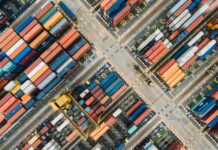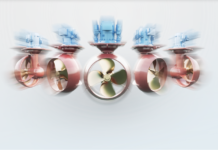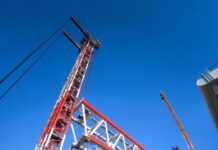
APM Terminals has awarded the civil works and electrification contract for the expansion of its Maasvlakte II (MVII) container terminal in Rotterdam, Netherlands, to the CareGo consortium, which includes ABB, Dura Vermeer, and GMB.
This expansion spans a 51-hectare container yard, doubling the terminal’s capacity and positioning it as one of the world’s most advanced fully automated facilities.
In addition, the new area will feature 31 additional yard blocks, expanded quay areas, and dedicated truck and rail zones, alongside supporting infrastructure. The Rotterdam Port Authority has already completed 1,000 meters of new deep-sea quay to support this project. Financial details of the contract remain undisclosed.
The CareGo consortium was selected for its expertise in terminal electrification and construction. ABB will handle the electrification, including prefabricated substations, terminal lighting, fiber optic networks, and power for cranes and reefers. Dura Vermeer and GMB will manage the civil works, covering pavement, concrete foundations, crane tracks, reefer racks, fencing, and the expansion of the rail terminal.
“Building a fully automated Container Terminal of this magnitude in such a short time frame is a challenging but also wonderful assignment. We have proven with APM Terminals MVII that we can do this. The new terminal is both highly sustainable and innovative. The participating companies in the construction consortium recognize themselves in this forward-thinking approach, making them perfectly suited for this challenging project,” stated Sander Lindemans, Project Director at CareGo.
Once completed, APM Terminals MVII will offer fully automated loading and unloading capabilities for the largest container ships globally. Designed for seamless sea-to-land transitions, the terminal will include secure automated zones to enhance safety by separating human and machine operations.
“As container terminals are becoming fully electrified, the need for resilient power infrastructure becomes even more important. With our solid track record in delivering automation solutions to container terminals and extensive expertise in designing and building reliable microgrids, we are well positioned to support this development,” commented Clara Holmgren, Business Line Manager of Ports at ABB Marine & Ports.
Moreover, the expanded terminal will feature six dedicated barge cranes and an integrated rail terminal, facilitating smooth container transfers to the hinterland and linking Rotterdam directly to the German rail network. Powered entirely by renewable electricity, the MVII terminal also uses energy-efficient buildings and infrastructure, with Lift Automated Guided Vehicles (L-AGVs) running on electric power instead of diesel. New Automated Terminal Trucks (ATTs) will be introduced, operating in mixed-traffic zones to improve efficiency.





